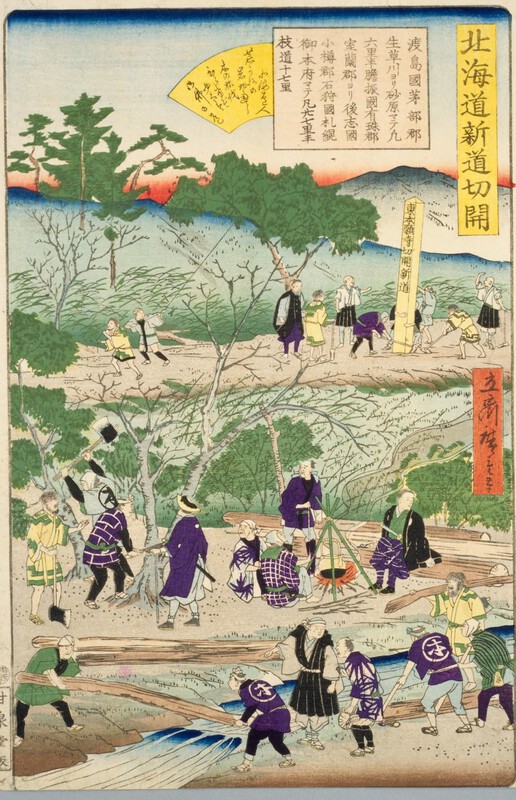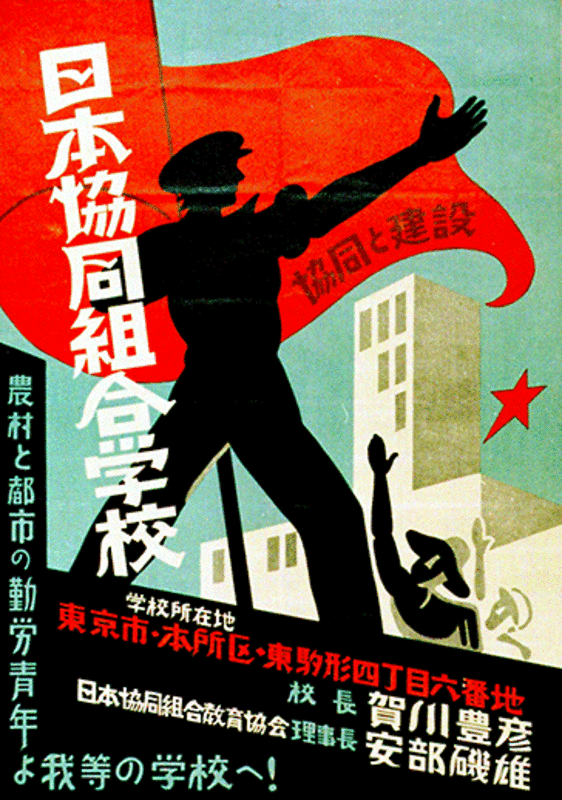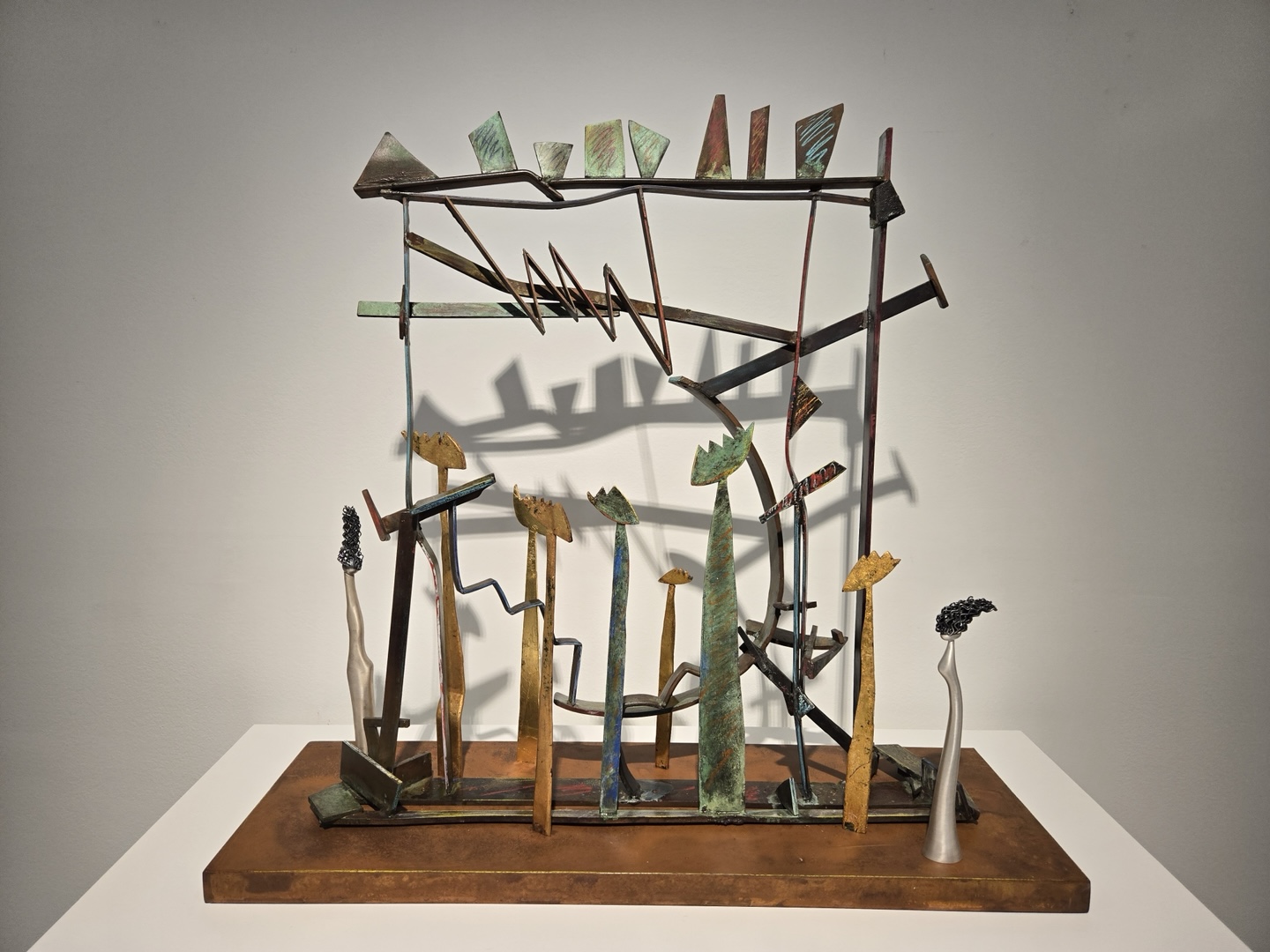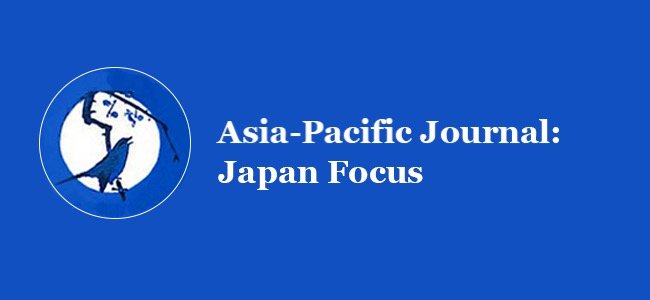Abstract: Upon the 50th anniversary of the Han-Mee Artists Association of Greater Washington, the curator of the exhibit Soaring (Narsha) at the American University Museum at the Katzen Arts Center, provides commentary on her vision for the exhibit as an exploration of Korean American identity.
I curated the exhibition Narsha, held at the American University Museum at the Katzen Arts Center from June 14 to August 10, 2025. This exhibition commemorates the 50th anniversary of the Han-Mee Artists Association of Greater Washington (formerly the Korean American Artists Association) and features selected works by distinguished Korean American artists based in the Washington, D.C. metropolitan area. The artists were selected not only for the maturity and originality of their artistic practice, but also in recognition of their contributions to the Association and their standing within the community. Spanning multiple generations, the participating artists engage with their Korean American identities in diverse and compelling ways. In that sense, the overarching theme of the exhibition may be understood as an exploration of Korean American identity itself.
The word Narsha, an archaic Korean term meaning “to soar high,” is drawn from Yongbieocheonga (Songs of the Dragons Flying to Heaven), the first Korean epic poem written in Hangul, the Korean alphabet, in 1447. In this foundational text, six dragons ascend to the heavens, a metaphor for new beginnings and national transformation from the Goryeo to the Joseon dynasty; “The six dragons of Haedong (East)take flight, and with each endeavor, they are blessed with heavenly fortune…” The six dragons of the East refer to the six generations from Mokjo (1204-1274) to his great great grandson Taejong (1367-1422), whose achievements laid the foundation for the establishment of the new dynasty. Just as history is built upon the accumulated efforts of ancestors, every flight requires a running start. Like plants patiently enduring the passage of time before blooming or migratory birds preparing for a long journey, the act of soaring is always preceded by an extended period of preparation and endurance.
The Han-Mee Artists Association of Greater Washington (hereafter referred to as HMAAGW)’s history embodies this idea; it has taken a village—and five decades of dedication—to arrive at its current form. Narsha is the appropriate title for this exhibition as it gestures toward uplift and momentum without imposing thematic constraints or stylistic limits. In this spirit, the exhibition seeks to highlight the wide-ranging practices and distinct voices that define the Korean American artistic landscape today—diverse, dynamic, and continually in motion. While Narsha offers an abstract yet hopeful framework for envisioning a collective future, the underlying curatorial theme I pursued was identity as it shifts across generations and individual artistic perspectives. Rather than a singular narrative, the exhibition presents a constellation of personal approaches to identity—shaped by cultural memory, migration, and artistic attitude—revealing the complexity and richness of the Korean American experience.
Just as that early verse symbolized the hopeful rise of a new era, this exhibition honors five decades of artistic growth, resilience, and community-building of the HMAAGW and envisions its new phase. In celebration of the group’s 50th anniversary, Soaring (Narsha) reflects on the collective journey and shares the hopes of both the collective and the individual. Through diverse mediums, genres, and perspectives, the artists capture their layered identities and shared histories as diaspora, while also reaching toward new creative heights, fueled by a transcendent desire for beauty, expression, and belonging in the new home. Therefore, this is the key conceptual framework of the exhibition: how each artist navigates and negotiates the question of identity. Some artists feel a sense of responsibility to reference Korean cultural icons, histories, or aesthetics in their work. Others approach identity more fluidly, freely hybridizing the multiple cultures they are exposed to—whether Korean, American, or global. Still, a few artists actively seek to transcend any cultural labeling altogether.
Korean emigration to the U.S. began as early as 1903, but after the passage of the U.S. Immigration and Nationality Act of 1965, there was a tremendous increase in the number of immigrants, and a distinct Korean American identity began to take shape. Early immigrant artists faced significant hardships due to prevailing prejudices and the biased expectation that their works should embody an “Orient” quality, far from the mainstream of Western modernism. As a result, the question of cultural and artistic identity has been a persistent issue for these artists. When HMAAGW was founded in 1975 with three members (Sam-Kyun Yoon, Komelia Hongja Okim, and Yeong-Hi Paik), the situation had not yet progressed much in terms of recognition or acceptance of Korean American art within the broader American artistic community.[1] They, just like any early immigrant artists, faced challenges in navigating the complexities of their dual identities—caught between the expectations of both their homeland and their new home. This struggle for identity was compounded by the broader societal prejudice, which often exoticized their work or marginalized it as being “other,” as criticized in the seminal book Orientalism by Edward Said who defines the title term as “the colonized, often marginalized, groups and cultures viewed as distinct and inferior to the dominant Western culture.”[2]
It wasn’t until later—particularly following the 1992 LA Riots, the growing awareness of Korean American identity, and nationally led diversity, equity, and inclusion (DEI) initiatives—that the group began to make significant strides in shaping their own artistic voice and contributing meaningfully to the broader American cultural landscape. In this regard, the current generation of artists is working under far more favorable conditions and should acknowledge with gratitude the efforts and sacrifices of the previous generations that made such an environment possible. Despite diverse challenges, the founding members of HMAAGW remained committed to forging their own path. They have grown into a vital platform that not only shows artistic excellence, but also fosters dialogue about identity, heritage, belonging, and social justice, and has expanded its presence both locally and nationally, while nurturing emerging artists and strengthening the cultural interaction between Korea and the United States.
Korean American artists found themselves “in between” two or more cultures. Many, if not all, continue to feel a full sense of belonging neither to their home country nor to the United States. This has been described as being in a state of “liminality” by anthropologist Victor Turner, or more recently “interstitial subject” by a scholar of Ethnic Studies (and a founding member of the Department of Ethnic Studies at Berkeley), Elaine Kim.[3] Korean American artists experience confusion and shock due to their fringe exposure to both cultures, but as time passed, they could blend the rich and diverse visual and cultural experiences of the two or more, resembling Turner’s “rite of passage” in their conscious growth carrying their dreams forward with unwavering hope.
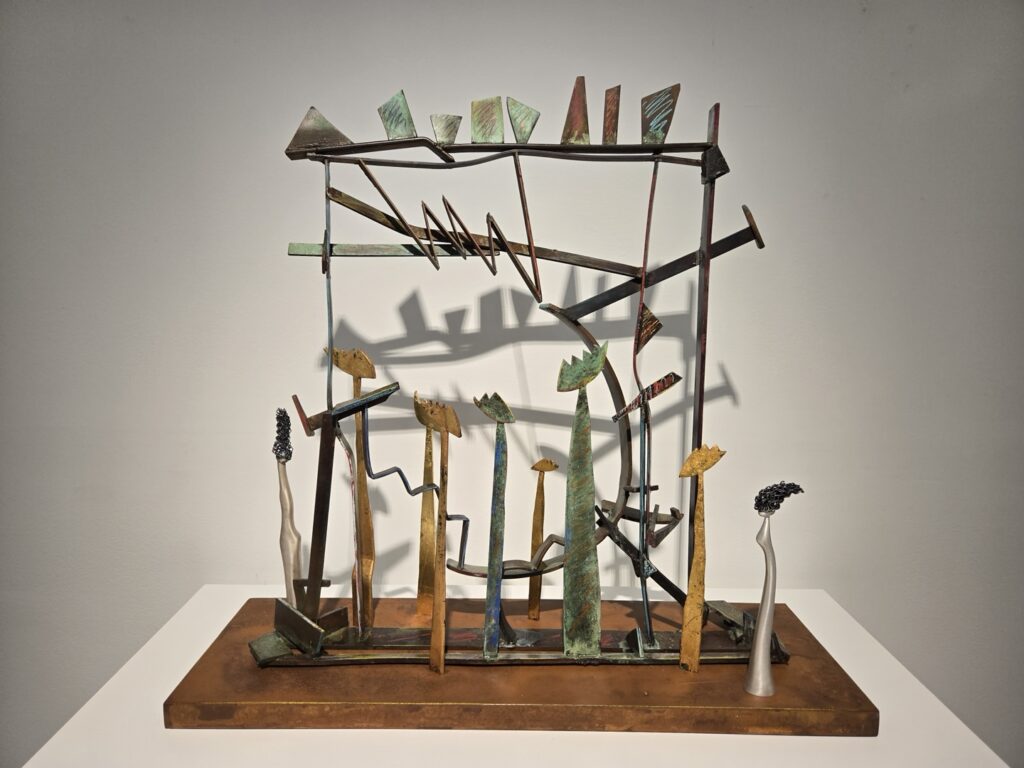
While earlier Korean American artists in the U.S. had to navigate the challenge of preserving their cultural heritage and conforming to Western modernist norms, a younger generation has embraced postmodern eclecticism, more freely synthesizing stylistic elements, cultural symbols, and narrative frameworks from both Korean and American contexts. Komelia Hongja Okim, for example, in Rainbow Landscapes (2023–24) (Fig.1), integrates influences from Russian Constructivism, Cubism, and Geometric Abstraction to articulate her immigration experience. Her work reflects the strength and resilience of a determined woman – representing her self-portrait – who fortifies their heritage while pursuing the American dream with a palette of Korean tradition. An artist like Yeong-Hi Paik, who began her practice in traditional East Asian painting in Korea, had to take a greater leap—indeed, a profound challenge—when she pursued Western art at an American art school. Her Landscape with Lake (2024), is rendered in oil, yet it quietly resonates with the sensibility of East Asian landscapes that center on the moon—a subject imbued with tranquility and the beauty of emptiness. These works evoke the iconic “moon jars” famously celebrated by modern Korean painter Kim Whanki—symbols of quintessential Korean aesthetics—while also echoing the refined forms of Western color field abstraction.
Similarly, Sumita Kim’s Sim Chung (2022) presents tendencies of Abstract Expressionism, German Expressionism, and Surrealism, yet at its core lies a deeply Korean narrative. Drawing from the 18th century folktale The Tale of Sim Cheong, one of Korea’s most iconic classical stories, the work reflects the image of a sacrificial Korean woman who throws herself into the sea to restore her blind father’s sight. Through this fusion, Kim reinterprets a traditional tale of filial piety and feminine devotion within a contemporary visual language, embodying cultural memories charged with the Korean sentiment of Han (grudge) of women.

Gyujin Lee’s Disquiet Unveiled (2025) (Fig.2) also captures the coexistence of surreal reality and fantasy mixed with automatist techniques and mixed media. Yet the work is equally drawn to the realm of children’s fairy tales, particularly The Little Mermaid. The mermaid’s impossible dream of becoming human resonates as a kind of self-portrait of the artist—an allegory of longing and transformation. This dreamlike narrative unfolds alongside traditional Korean hanok housing architecture, suggesting a layered coexistence of cultural history and personal memory. Since 2020, Little Red Riding Hood has appeared in Lee’s works playing various roles—sometimes as a bystander, other times as an active participant—embodying multiple layers of narrative and perspective. This is a work that clearly demonstrates pastiche, a post-modern technique that appropriates existing images or symbols and harmonizes them with the work in a new artistic way.
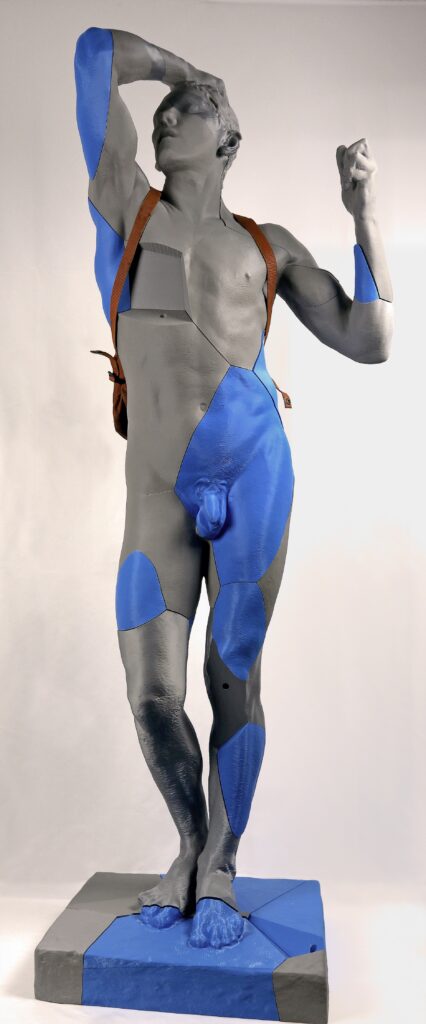
This exhibition brings together many young artists who weave parodies and pastiches — the two defining strategies of postmodern art — into their work. Tae D. Kim-James boldly reimagines The Age of Bronze, the iconic life-sized sculpture by the nineteenth century French artist August Rodin in his Excavated Bronze: After Rodin (2025) (Fig.3). Abandoning traditional materials like plaster or bronze, Kim-James constructs the figure from biobased plastic, slinging a commonplace backpack over its shoulders — a jarring yet familiar twist. Though the silhouette remains recognizable, the work is utterly reborn: its substance, its color, its very soul transformed. Drawing inspiration from Daniel Arsham’s notion of “fictional archaeology,” Kim-James challenges us to view the artifacts of our everyday lives as relics unearthed by future civilizations — a daring act of imagination that blurs the line between memory and mystification.

Minsun Oh Mun’s pastiche work Dragon (2025) (Fig. 4) aligns seamlessly with the spirit of this exhibition. Inspired by the dragon — the mythical creature at the root of Narsha‘s etymology— she first rendered the Chinese character for “dragon” in ancient seal script, then filled the form with a vivid tapestry of cultural emblems that she encountered. Within the dragon’s body, we glimpse symbols of American power: the first U.S. president George Washington, the Lincoln Memorial, the Capitol Building, and the Statue of Liberty. Interwoven among them are echoes of Korean folk painting — a woman in a hanbok playing the janggu drum (Korean traditional percussion), an owl as the symbol of wisdom, and camellias, symbols of prosperity, mingling with Washington, D.C.’s famed cherry blossoms. The artist notes that the dragon’s pearl — typically held in its mouth — represents a blessing, and, in her interpretation, denotes that only those who are prepared can seize opportunity when it arises. The artist, embracing her hybrid identity, weaves together fragments of diverse cultures within the calligraphic form of the dragon’s character, creating a powerful expression of her multifaceted and hybridized self.
Homi Bhabha, one of the central figures in postcolonial theory, introduced the concept of hybridity as the emergence of new cultural forms born from intercultural encounters, challenging essentialist notions of identity and culture.[4] He calls this a hybrid space full of tensions, struggles, and contestation between different cultural productions, but its outcome is most “dynamic, enchanting, and productive.” Much like the theory of “heterosis” in Biology — where the hybrid of two distinct species proves stronger and more resilient — the visual vocabulary of diaspora artists is, in most cases, far richer and more inventive than that of those who have lived in a single place all their lives.

Hyun Jung Kim’s Blind in Art — Humans Are Jewels (2021) (Fig.5) is a dazzling installation piece: an antler-like silk crown, radiant in colorful saekdong hanbok fabric (Korean traditional dress) patterns, adorned with jeweled appendages like precious gems — her previous version of the golden crown was decorated in Braille. But upon closer inspection, this crown serves more as a pedestal — its jewel-like ornaments are, in fact, photographs of audience members wearing the artist’s previous crown works. Though the work adopts the form of a Western contemporary art style of installation (mixed media and interactive work with audiences), its soul is deeply rooted in Korean tradition. The crown echoes the 5th century ancient Shilla dynasty crown with tree shaped vertical elements connecting heaven and earth; while its tiny gold disc and jade ornaments, called gogok, are traditional symbols of abundance and fertility. Here, these precious ornaments are replaced by images of audiences wearing the crown, embodying the artist’s aspiration to help everyone through recognizing their own worth and rediscovering their self-confidence. The silk is dyed in seven colors that consist of five directional colors (obangsaek), adding more colors, for aesthetics. The five sacred colors of Korean cosmology have long been believed to ward off evil spirits. Could it be that the artist’s creation of the crown reflects an unconscious longing of a diaspora artist to bestow royal or at least legitimate authority upon the Korean identity of herself and her viewers as well?
Not all diaspora artists create works that incorporate Korean references. Certain artists, mostly those of younger generations, even resist being categorized by any label, such as “Korean American” or “Woman” artist, challenging expectations of Korean-themed work; they wish to be recognized as individual artists. This emerging trend is referred to as “post-identity,” famously proclaimed by the performative photographer, Nikki Lee. For example, artists like Jinchul Kim, Jean Jinho Kim, Sunhee Kim Jung, Joo Kim, and Suli, among many, are reaching their own mature style whether abstract or figurative, without necessarily integrating elements of “Koreanness” into their work.
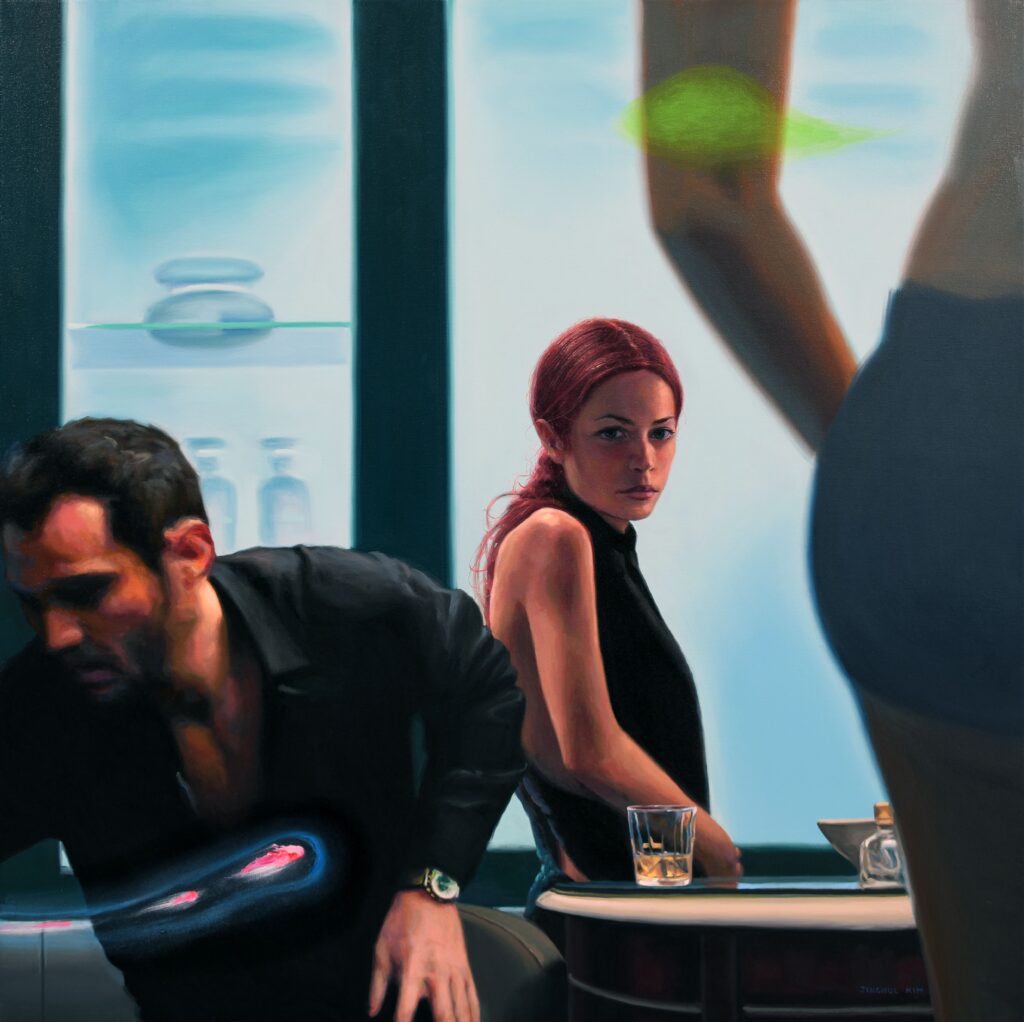
Jinchul Kim’s Rendezvous (2023) (Fig.6) powerfully exemplifies this sensibility. His portrait, rendered in hyper-photorealist technique, portrays a fleeting moment of a zoomed snapshot-like scene. The two main figures appear detached, each absorbed in their own thoughts or tasks, while a third figure on the right is only partially visible through a back silhouette. In its deliberate avoidance of any overt message or narrative, the work recalls modernist ideals. Yet the red brushstroke near the bottom left, reminiscent of a falling meteor, and the green and blue strokes near the top signal Kim’s blending of photographic figuration and abstract painting — a clear gesture toward postmodern eclecticism beyond the boundaries of modernist media demarcation. His assembled imagery and emotionally isolated subjects echo Edward Hopper’s 1942 work, Nighthawks, but Kim’s canvas remains far more open-ended in meaning. The interpretation is entirely left to the viewer, transforming his representational strategy into an array of signs — signifiers — awaiting individual decoding. As the artist paradoxically asserts, this is a “new definition of representation” or an “inventive personal semiotic.” The signifiers are present, but the signifieds must be constructed by the audience, resulting in a new form of representation that can be as disorienting as it is thought-provoking. By presenting portraiture in a poetic, ambiguous manner, Kim challenges both conventional modes of depiction and the ways in which we experience contemporary visual media. His work, situated at the crossroads of painting, photography, and even media, boldly dismantles artistic and cultural binaries and essentialism. As the title Rendezvous (meaning “meeting”) suggests, the artist acts as a mediator, bringing and orchestrating together disparate elements — East and West, representation and abstraction, painting and media art, presence and absence — becoming a unique postmodernist and a prime example of post-identity practice among Korean diaspora artists.
This delicate but challenging act became a source of inspiration and creativity, pushing them to question and redefine what it means to be Korean, Korean American, and a visual artist. Perhaps we are approaching a new era of creation as the notion of “Koreanness” can no longer be reduced to a singular, fixed definition. Because the very notion of what it means to be Korean — and what constitutes “Koreanness” — is undergoing a profound transformation. As the myth of a pure, blood-shared people (danil minjok) of Korea crumbles, and as international marriages, immigration, adoption, and nomadic lifestyles become more common among artists, even the very definition of what it means to be Korean is beginning to shift. Through their art, these artists sought not only to preserve their roots, but also to create a new cultural identity—one that could reflect the dynamic experience of being caught between two or more worlds. This exposure to diverse cultures becomes a source of creative strength, allowing these artists to transform challenges into opportunities for rich expression and personal artistic growth.
What makes this group remarkable is its ability to embrace these differences and genuinely appreciate one another’s practices. This spirit of mutual respect and openness has allowed the association to grow steadily and positively over the half century. This dynamic is vividly reflected in the exhibition, where diverse voices and practices coexist—not in uniformity, but in dialogue—revealing the strength that comes from difference rather than sameness. I hope that viewers come away understanding that the work of Korean diaspora artists cannot be reduced to a single definition or style. It is remarkably diverse, complex, and continually evolving. I also expect that they recognize these artists’ ongoing efforts to engage with and contribute to the forefront of the contemporary Western art scene.
On this 50th anniversary, I offer my heartfelt wishes that Korean American artists continue to soar high and far, gain wide and expansive viewpoints of the world, and become pioneers leading the future of the global art world!
Note: This reflection is based on the exhibit catalog, written by the author.
Notes:
[1] In 1973, twelve Korean American artists in the Washington, DC area began gathering as a collective. Their first group exhibition was held in May 1975, an event that marked the founding of the Korean American Artists Association (KAAA), later renamed the Han-Mee Artists Association of Greater Washington (HMAAGW). Of the original twelve, only three founding members remain active today, carrying forward the legacy of this pioneering community.
[2] Edward Said, Orientalism (New York: Vintage Books, 1979), 144.; Komelia Hongja Okim recalled when she was hired as a professor at Montgomery College in 1972, her colleague told her that she was hired because of her race and gender, not because of her professional excellence. Author interview with Komelia Hongja Okim, April 29, 2025.
[3] The term “Liminality” comes from the Latin word “limen,” meaning a boundary. Victor Turner defined it as “an intermediate stage or state experienced during a rite of passage, in which the subject undergoes ambiguity.” However, he describes it as a process that transforms the state of confusion and shock into a meaningful state. Victor Turner, Celebration: Studies in Festivity and Ritual (Washington, D.C.: Smithsonian Institution Press, 1982), 26; Elaine H. Kim, “Interstitial Subjects: Asian American Visual Art as a Site for New Cultural Conversations,” in Fresh Talk Daring Gazes by Elaine H. Kim, Margo Machida, and Sharon Mizota (Berkeley: University of California Press, 2003), 1–50.
[4] Homi Bhabha, The Location of Culture (London; New York: Routledge, 2004), 37-38; Jung-Sil Lee, Modern and Contemporary Korean Art in Context (1950-Now) (London: Bloomsbury, 2025) see Chapter 2.3. “The Korean American Diaspora,” 122-137.

